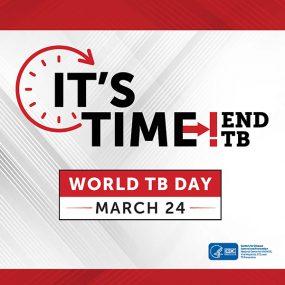 Each year organizations across the globe recognize March 24 as World TB Day to commemorate the discovery of the bacterium that causes tuberculosis (TB), raise awareness about the impacts of TB, and highlight opportunities to combat this disease. This year’s theme, “It’s Time,” urged leaders worldwide to commit to taking action to address TB. NACCHO interviewed Kimberly Townsend, RN, Nurse Administrator in the Montgomery County (MD) Department of Health and Human Services Tuberculosis Control Program, to learn more about their World TB Day activities and highlight an example of local participation in this global movement.
Each year organizations across the globe recognize March 24 as World TB Day to commemorate the discovery of the bacterium that causes tuberculosis (TB), raise awareness about the impacts of TB, and highlight opportunities to combat this disease. This year’s theme, “It’s Time,” urged leaders worldwide to commit to taking action to address TB. NACCHO interviewed Kimberly Townsend, RN, Nurse Administrator in the Montgomery County (MD) Department of Health and Human Services Tuberculosis Control Program, to learn more about their World TB Day activities and highlight an example of local participation in this global movement.
Tell us a little about the epidemiology of TB in Montgomery County. What is your baseline rate? Who is most impacted?
Montgomery County provided TB care for 65 individuals with TB disease in 2018, which is 28% of the TB disease cases in Maryland. We provide comprehensive TB disease care for an average of 50-60 individuals per year. Our case rate average over the past six years is 5.8/100,000.
Can you share what Montgomery County did for World TB Day this year? How did the idea for this come about and what are the goals?
This year, the TB Program’s goal for World TB Day was to increase awareness about latent tuberculosis infection (LTBI) screening, reporting, diagnosis and treatment in our community. This idea was precipitated by the recent implementation of LTBI reporting as well as the subsequent need for treatment of LTBI (TLTBI).
Community partners and providers were offered resources about LTBI via phone consultation, fax, email, or an on-site visit by one of our program staff. Resources included a copy of a letter to providers previously sent from Maryland Department of Health with links to state guidelines for LTBI screening, treatment and reporting. Additionally, they were provided with updated information about our TB Control Program locations, contact information, services, hours, and team members.
How did it go? What do you hope will be the longer-term outcomes of this effort?
I think it went well! Our program conducted four facility site visits in the community during the week of World TB Day, and three additional visits are scheduled for the second week of April. Our administrative staff reports that they responded to approximately 25-30 phone calls specifically related to TB infection and treatment during March and forwarded information packets out to community providers and facilities. One of our TB Program physicians will present a webinar at a community hospital and will highlight the importance of LTBI and TLTBI.
We are hopeful that long-term outcomes related to these outreach activities include strengthening our collaborative relationships with community providers in an effort to increase TLTBI and prevent future TB disease cases.
What were some the challenges you faced in planning and implementing this activity and what lessons will you take from this campaign for future public health events?
We learned that community healthcare facility staffing and models are fluid. Therefore, ensuring that the information reaches the clinical team members that screen, diagnose, and treat LTBI was a challenge. We also learned that the clinicians and communities that they serve are diverse and have varied information about LTBI and TLTBI. Lessons learned include the importance of incorporating creativity and flexibility when communicating information; for example, being able to offer the information in a manner that meets the needs of the community provider or facility was helpful.
What advice do you have for other local health departments (LHDs) trying to raise awareness and increase reporting related to LTBI?
I often speak with colleagues about this as many of us share similar challenges related to LTBI. It certainly sounds like there is a lot of great work and effort related to this issue currently occurring in LHDs. My advice is to continue to identify and create opportunities to communicate with healthcare providers in the community about LTBI and TLTBI on a long-term basis.
The Centers for Disease Control and Prevention estimates that 5-10% of individuals with LTBI will progress to active TB disease. This represents a threat to TB elimination and yet LTBI screening and treatment is not implemented as widely as it could be in many places. What role do you think LHDs can play in addressing LTBI?
Local health departments play an essential role in addressing LTBI. As TB experts, we serve as a resource for our community providers and partners about TB infection screening, diagnosis, and treatment education. Continued education, communication, and collaboration with our community healthcare providers regarding the significance of TLTBI is an important part of this role.
To learn about what other local health departments and local public health professionals are doing, check out the CDC’s 2019 U.S. TB Elimination Champions website. Winners include Florida Department of Health in Duval County, Monroe County (NY) Department of Public Health, and Dr. Greg Stern, Health Officer for Whatcom County (WA) Public Health.


